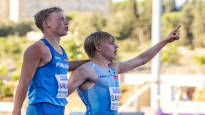Finland won two golds and four medals at the under-20 European Championships that ended on Thursday in Jerusalem. A clear trend in top Finnish athletics has long been that the majority are women.
Therefore, in the successful under-20 team, it is interesting that all four medalists are young men. Jere Haapalainen and Antti Sainio achieved a sensational double victory in the 400-meter hurdles, Max Lampinen moukaroi gold and Rasmus Vehmaa won silver in the 110 meter hurdles.
Nephew of Rasmus Vehmaa Kasperi Vehmaa was fourth in length. There were a total of nine points. Among the women, they only reached the fifth place in the points, i.e. in the top eight Tuuli Järvinen in seipää and sixth Mint Laurila in the ball.
Lampinen and Haapalainen were born in 2004 and Sainio and Vehmaat in 2005.
Director of coaching and training of the Finnish Sports Association (SUL). Jarkko Finni says that it is difficult to find a common denominator for the talented boys of those two age groups. The age group of those born in 2006 has Topi Parviainen (spear), Aatu Kangasniemi (moukari) as well as Joonas Kumpulainen (800 m) such talents.
In the big picture, the situation is that women are floundering and there is not enough scope on the men’s side. One example of this is the Finnish World Cup team next week in Budapest. There are 27 women and 13 men.
There were also more women in the team at the under-23 European Championship in Espoo, for example. Although four of the ten medalists at the Espoo Games were men, the brightest talents have mainly come from the girls’ side.
– It is a clear change that there are more girls/women in the team and there will also be more success. The change has been drastic in ten years. However, there was a good age group of boys there, says Finni.
– However, I wouldn’t draw a very big conclusion based on 1-2 years of birth. The trend is quite clear, Finni refers to the clear majority of girls in Finnish athletics.
Weak numbers of participants
The situation can be seen more clearly at the grassroots level. For example, there was a shortage of boys in many sports at the 14–15-year-old championships held in Imatra last week.
This was especially visible among the 14-year-olds. For example, there were only four competitors in the javelin race.
Athletics is a popular hobby among girls. Correspondingly, the number of boys has been falling for a long time. Finni says that this trend has been in the air throughout the 2000s.
– When we talk about the 14-15 year old championships, we are talking about athletes who started their hobby in the middle of the last decade or later. There is a clear difference in the number of licenses and hobbyists for girls and boys. This is also the case for those who compete, Finni opens.
– The current value competition team reflects what has happened on the children’s and youth side 10–20 years ago. The share of girls at the beginning of the path at the age of 8–10 is almost two-thirds.
Not enough athletes
Finni reminds that a few other things also affect the number of participants in certain sports. In the games, you can participate in two sports. Here, clear favorite sports are highlighted.
The popularity of certain species is also a wave movement. Although Haapalainen and Sainio scored a double victory in the 400-meter hurdles, at least in the 14-year-olds’ 300-meter hurdles, there is no boom to speak of.
There were only two participants.
– In general, Imatra had very few boys on the fence side, Finni states.
Finni says that, for example, in many field sports, the lack of masses has been visible for a long time.
– For example, high jumping has long been a sport where there have been very few competitors in the boys’ WC. However, running distances are always appealing, Finni refers especially to smooth sprints.
Finni reminds that Finland is currently doing really well in value competitions in relation to the number of enthusiasts. It is a far cry from the peak years of the 1980s and 1990s.
Finni says that SUL’s system and coaching work well. However, the small number of boys poses its own challenges.
– When there are few boys and young men, and the group drops out along the way, there are not enough athletes for all sports. There are gaps and weaker sports on the men’s side.
– The number of enthusiasts is so small that there are by no means enough participants in all sports of all age groups. On the girls’ side, the situation is more stable, because the number of enthusiasts is much larger.
1. Max Lampinen, moukari
1. Jere Haapalainen, 400 m aj
2. Antti Sainio, 400 m aj
2. Rasmus Vehmaa, 110 m aj
4. Kasperi Vehmaa, height
5. Tuuli Järvinen, stick
6. Minttu Laurila, ball
7. Juho Suominen, puck
8. M 4×400 m
The strength of boys
Although there are basically fewer boys, Finni finds one clear good side.
– Boys’ persistence is better than girls, because boys are more eager to compete. The competition binds the hobby much more closely, which can be seen in the fact that the boys become more attached to the sport.
– The number, which is large among 8-11-year-olds, shrinks when there are boys who compete longer. However, the challenge is whether there are enough potential enthusiasts for all sports. We have to succeed better in coaching individuals, which has certainly been seen.
